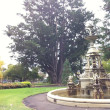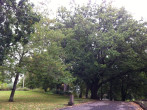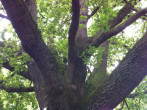HAMILTON BOTANIC GARDENS
KENNEDY STREET AND MARTIN STREET AND FRENCH STREET AND THOMPSON STREET HAMILTON, SOUTHERN GRAMPIANS SHIRE
-
Add to tour
You must log in to do that.
-
Share
-
Shortlist place
You must log in to do that.
- Download report
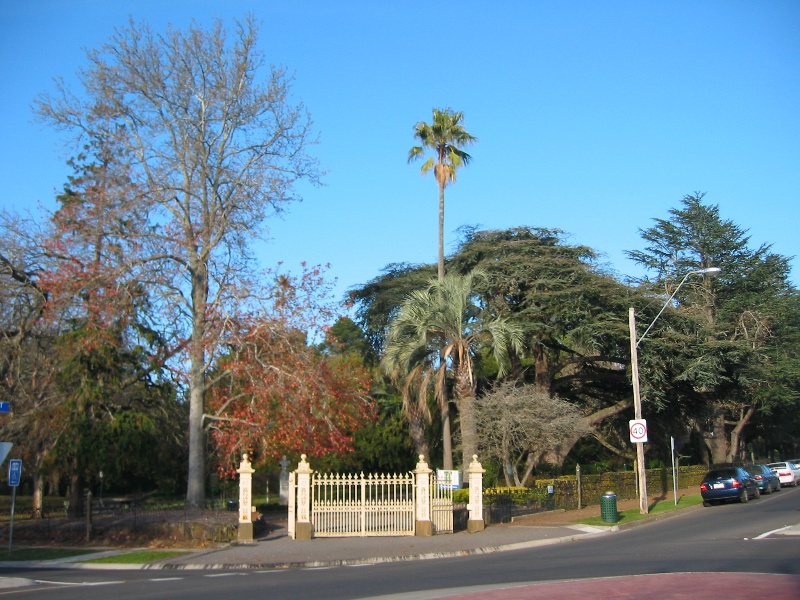

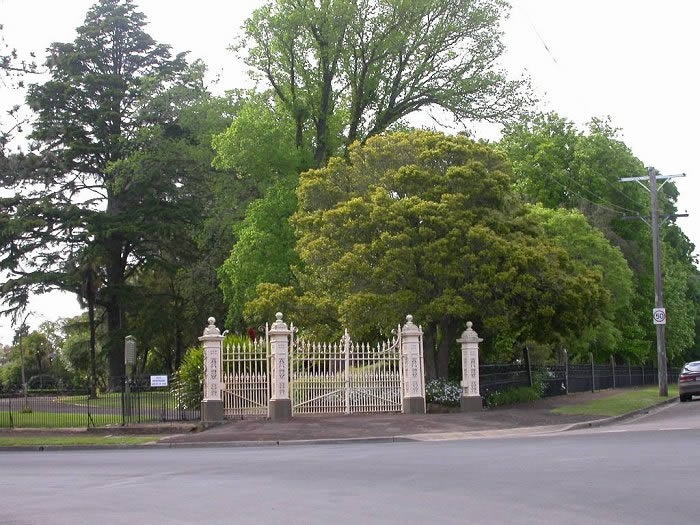

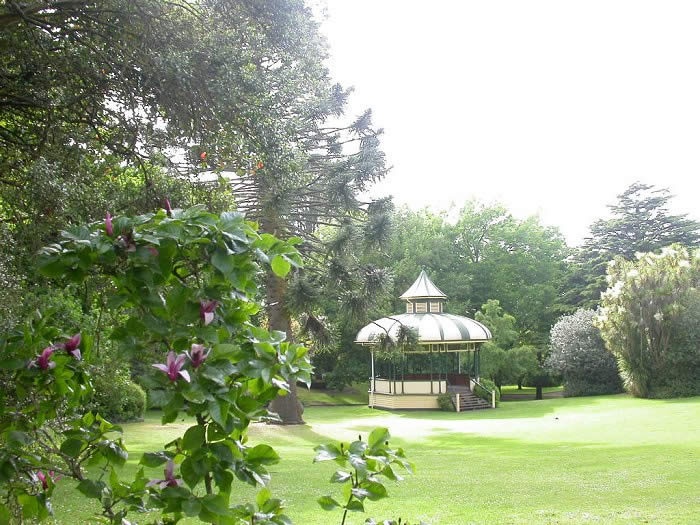

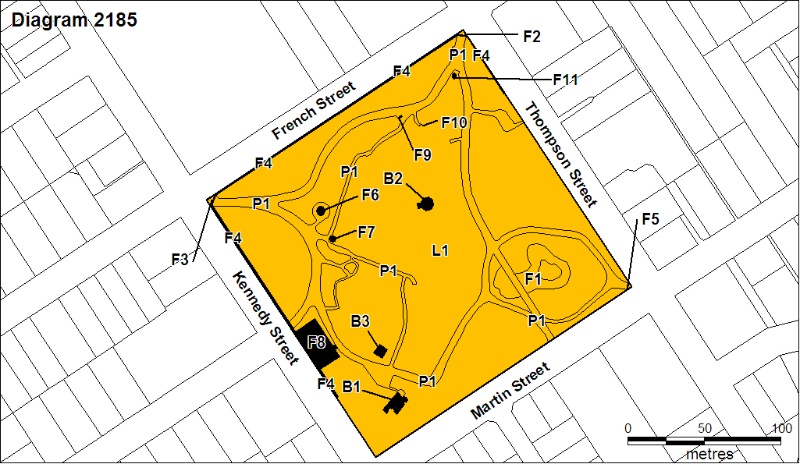
Statement of Significance
The Gardens have an encircling path with shrubberies and trees planted around the perimeter. A network of curved asphalt and gravel paths divide the centre of the garden, defining large sweeping lawns dotted with mature specimen trees and irregular shrubberies. These include a mature collection of oaks, conifers and elms as well as a number of rare specimens.
-
-
HAMILTON BOTANIC GARDENS - History
HISTORY:Sources:Nigel Lewis Richard Aitken Pty Ltd in association with Francine Gilfedder and Associates, Hamilton Botanic Gardens Conservation Analysis, August 1993.Francine Gilfedder and Associates in association with Nigel Lewis Richard Aitken Pty Ltd, Hamilton Botanic Gardens Conservation Policy and Strategy for Implementation, 1994.National Trust classification 'Hamilton Botanic Gardens' G13112 prepared by R Aitken Jun 1990.City of Hamilton Conservation Study Volumes 1 & 2, by Timothy Hubbard Pty Ltd, in conjunction with Carlotta Kellaway and Michael Looker, June 1991.CONTEXTUAL HISTORY
From the mid nineteenth century, fuelled by the gold rush and colonial government polices, Victoria developed a tradition of municipal botanic gardens in many country town of considerable size. This resulted in Victoria having the finest collection of provincial botanical gardens of all Australian states. Hamilton Botanic Gardens was one of four early botanic gardens set aside in the Port Phillip District of New South Wales, the others being located in Melbourne, Geelong and Portland.
Most of the regional botanic gardens developed as landscaped gardens, although there was a sharp contrast between these sites and the various municipal parks and gardens where an emphasis on floral displays and ornamentation tended to dominate, especially in the twentieth century.
HISTORY OF PLACE
The township of Hamilton, (then known as Grange), was surveyed in 1850, and in May 1851 the plans were approved by the authorities in Sydney and the township site gazetted. Section 10, the current site of the Botanic Gardens, was included in the 1850 survey and despite being marked into 20 small allotments, was not included in the early land sales. The first known reference to a garden on this site was in September 1853, but it was not until 25 January 1870, that the 10 acre (4 hectare) rectangular site bounded by French, Thomson, Martin and Kennedy Streets was temporarily reserved by an Order in Council. On 28 January 1870, it was gazetted for public garden purposes.
Plants were supplied by the Melbourne Botanic Gardens with initial planting and layout undertaken by William Ferguson, who was Inspector of State Forests and also working at the Melbourne Botanic Gardens in the interim between Mueller's dismissal as Director and William Guilfoyle's appointment as Director in 1873. An early work was the construction of a pavilion or bandstand on a high point towards Thompson Street, although it was later demolished in c.1924-30 after it fell into disrepair. By 1878, the unsatisfactory state of the reserve resulted in the appointment of Peter McKinnon as gardener, who was soon followed by James Bailie (1878-82). A turning point in the history of the Hamilton Botanic Gardens occurred in 1881 when the Council obtained the services of William Guilfoyle, Director of the Melbourne Botanic Gardens, who had previously prepared designs for the Warrnambool Botanic Gardens in 1877, and the Koroit and Horsham Botanic Gardens in 1880. His new design, dated 18 October 1881, was progressively implemented over the following decades and, according to a report in the Hamilton Spectator on 7 January 1882:
'the lawns, gravelled walks, clumps of trees, flower beds, summerhouses etc, are all charted out, even the particular kinds of trees or shrubs intended to occupy every position, has been selected with a view to produce the best landscape effect and harmony of colours.'
The first items to be implemented were the series of new 'walks' or paths. These included sections of the main encircling promenade which, for a time, created a confusing mix of Ferguson's existing layout and new Guilfoyle-inspired paths. By late 1883 the lake and its fountain (demolished in the late 1950s) as well as a reticulated water supply for the Gardens had been installed. Goldfish and swans were introduced in 1885 as forerunners of the present zoological section of the gardens. In 1887 seats were provided and a large lawn, presumably the present central lawn was laid out. The curators responsible for the early implementation of the Guilfoyle plan were John G Wilson (1882-85), Isaac Thomason (1885-88) and J Upham (1888-89). HS James was appointed curator in 1889 and stayed until 1903, ushering in a long period of stability in the management of the Gardens. During the 1880s and 1890s many new plants were obtained from prominent nurserymen and garden beds and shrubberies created. In 1893 a cannon was placed in the gardens and large cast iron gates erected at the Thompson Street (northern) entrance. By the end of the century, the Gardens were described in the Weekly Times (4 May 1894), as a 'source of wonder' as the trees, especially the conifers planted by Ferguson, and the garden beds were maturing.
Randolph Hughan commenced as curator in 1903 the same year that the Council was appointed Committee of Management for the Gardens. With Hughan staying for the next 42 years in the job, this period of stability was complemented by consistent funding by the Council and a high level of public interest in the gardens. In 1903 a fernery was constructed near the French Street (western) entrance, and was most likely relocated by 1930s to a site near the court house gate, (but was also demolished by 1961). In1908 the curator's cottage was relocated from French Street to its present site which perhaps signalled the creation of the works depot on its current site. By this date the gardens were lit by electricity. Major capital works occurred in 1908-9 with the erection of an iron and timber perimeter fence, gates, a fountain (dedicated to the Australian Natives Association), a fernery and grotto complete with an arch of whale bones and a stump set in concrete and coved by a pagoda - the artefact said to be a relic of Mitchell's travels (removed in 1984). A large ornamental fountain to commemorate the Hon John Thompson MLA (d.1917), for 22 years the Member for Dundas, was opened by the Premier of Victoria, Mr Harry Lawson on Friday 4 April 1919.
Most developments during the inter-war period were piecemeal namely commemorative objects and planting placed in the gardens. By the 1960s a children's playground, wishing well and paddling pool had been added.
In 1984 - 85 a rejuvenation program commenced with additional funding provided to mark Victoria's Sesquicentenary. Works included the identification and labelling of plants, tree surgery and repairs on the Thompson fountain as well as the addition of some advanced exotic tree species. In the early 1990s, works included the painting of the entrance gates and restoration and construction of sections of the perimeter fencing and landscaping inside the entrance gates. Major works undertaken in 1989-90 included the relocation of the bandstand from Melville Oval, restoration of the Thompson fountain, refurbishment of the cannon with a new base and the removal of the 1960s sound shell. In addition, the Garden State Committee provided funds to light the fountain and bandstand and to establish the Abutilon Collection.
The Friends of the Hamilton Botanic Gardens Inc were formed in 1987 and still remains very active. They funded and designed a sensory garden in 2006 and use the cottage for meetings and displays. In 2000 the Southern Grampians Shire Council set up the Hamilton Botanic Gardens Advisory Committee to oversee the day to day operations of the Gardens.
HAMILTON BOTANIC GARDENS - Assessment Against Criteria
a. Importance to the course, or pattern, of Victoria's cultural history
The Hamilton Botanic Gardens are one of the earliest nineteenth century regional botanic gardens in Victoria. First surveyed in 1850-51 the land was set aside as a public garden in 1853, but was not gazetted until 1870.
b. Possession of uncommon, rare or endangered aspects of Victoria's cultural history.
c. Potential to yield information that will contribute to an understanding of Victoria's cultural history.
The Hamilton Botanic Gardens are important for the collection of plants characteristic of nineteenth and early twentieth century Victorian gardens, as well as representative of more specialised plant groups befitting the scientific role of a botanic garden. The planting includes many rare and uncommon specimens now often only found in botanic gardens or historic landscapes.
d. Importance in demonstrating the principal characteristics of a class of cultural places or environments.
The Hamilton Botanic Gardens are historically important as one of the most intact examples of a nineteenth century provincial botanic garden in Victoria. They are an early example of William Guilfoyle's design exemplify his ideas about planting as shown by therare 1881 plan and accompanying letter held in the collection of the Hamilton Art Gallery.
e. Importance in exhibiting particular aesthetic characteristics.
The Hamilton Botanic Gardens have important aesthetic characteristics as a nineteenth century provincial botanic garden, characterised by a lake, curved paths, perimeter plantings of conifers, plantings of specimen trees and shrubberies. The 'spires' of conifers in the Gardens and the spires of local churches pierce the skyline and make a significant contribution to the Hamilton urban landscape.
f. Importance in demonstrating a high degree of creative or technical achievement at aparticular period.
g. Strong or special association with a particular community or cultural group for social,cultural or spiritual reasons. This includes the significance of a place to Indigenouspeoples as part of their continuing and developing cultural traditions.
h. Special association with the life or works of a person, or group of persons, ofimportance in Victoria's history.
HAMILTON BOTANIC GARDENS - Plaque Citation
Established in 1853 and designed in 1881 by William Guilfoyle, these Gardens are one of the earliest and most intact regional botanic gardens in Victoria with several significant garden structures and rare plants.
HAMILTON BOTANIC GARDENS - Permit Exemptions
General Exemptions:General exemptions apply to all places and objects included in the Victorian Heritage Register (VHR). General exemptions have been designed to allow everyday activities, maintenance and changes to your property, which don’t harm its cultural heritage significance, to proceed without the need to obtain approvals under the Heritage Act 2017.Places of worship: In some circumstances, you can alter a place of worship to accommodate religious practices without a permit, but you must notify the Executive Director of Heritage Victoria before you start the works or activities at least 20 business days before the works or activities are to commence.Subdivision/consolidation: Permit exemptions exist for some subdivisions and consolidations. If the subdivision or consolidation is in accordance with a planning permit granted under Part 4 of the Planning and Environment Act 1987 and the application for the planning permit was referred to the Executive Director of Heritage Victoria as a determining referral authority, a permit is not required.Specific exemptions may also apply to your registered place or object. If applicable, these are listed below. Specific exemptions are tailored to the conservation and management needs of an individual registered place or object and set out works and activities that are exempt from the requirements of a permit. Specific exemptions prevail if they conflict with general exemptions. Find out more about heritage permit exemptions here.Specific Exemptions:General Conditions: 1. All exempted alterations are to be planned and carried out in a manner which prevents damage to the fabric of the registered place or object.
General Conditions: 2. Should it become apparent during further inspection or the carrying out of alterations that original or previously hidden or inaccessible details of the place or object are revealed which relate to the significance of the place or object, then the exemption covering such alteration shall cease and the Executive Director shall be notified as soon as possible.
General Conditions: 3. If there is a conservation policy and plan approved by the Executive Director, all works shall be in accordance with it
General Conditions: 4. Nothing in this declaration prevents the Executive Director from amending or rescinding all or any of the permit exemptions.
General Conditions: 5. Nothing in this declaration exempts owners or their agents from the responsibility to seek relevant planning or building permits from the responsible authority where applicable.
Building Exterior:
* Minor repairs and maintenance which replace like with like.
* Painting of previously painted surfaces (but not signs), walls, posts, and roofing in the same colour.
* Treatments to stabilise and protect timber, masonry and metal structures.Building Interior:
* Painting of previously painted walls and ceilings provided that preparation or painting does not remove evidence of the original paint or other decorative scheme.
* Removal of paint from originally unpainted masonry.
* Refurbishment of toilets including removal, installation or replacement of fixtures and fittings.Landscape:
* The process of gardening, mowing, hedge clipping, bedding displays, removal of dead plants, disease and weed control, emergency and safety works and landscaping in accordance with the original concept.
* The replanting of plant species to conserve the landscape character, conifer, elm, oak, poplar, and shrub plantings.
* Management of trees in accordance with Australian Standard; Pruning of amenity trees AS 4373.
* Vegetation protection and management of the possum population.
* Removal of plants listed as Prohibited and Controlled Weeds in the Catchment and Land Protection Act 1994.
* Repairs, conservation and maintenance to hard landscape elements, memorial plaques, asphalt and gravel paths and roadways, stone and concrete edging, fences and gates.
* Installation, removal or replacement of garden watering and drainage systems beyond the canopy edge of listed trees.Objects:
The temporary relocation, movement or external loan of a registered heritage object does not require permit approval by the Executive Director pursuant to the Heritage Act 1995 where the activity is performed in accordance with the accepted standards, policies and procedures of the organisation concerned.
The conservation, research or analysis of a registered heritage object does not require approval by the Executive Director pursuant to the Heritage Act 1995, where the activity is performed in accordance with the accepted standards, policies and procedures of the organisation concerned.
Minor Works : Note: Any Minor Works that in the opinion of the Executive Director will not adversely affect the heritage significance of the place may be exempt from the permit requirements of the Heritage Act. A person proposing to undertake minor works may submit a proposal to the Executive Director. If the Executive Director is satisfied that the proposed works will not adversely affect the heritage values of the site, the applicant may be exempted from the requirement to obtain a heritage permit. If an applicant is uncertain whether a heritageHAMILTON BOTANIC GARDENS - Permit Exemption Policy
Conservation and management of the Hamilton Botanic Gardens should retain the landscape character (referred to as the "Guilfoyle style") to include conifers, evergreen and deciduous plants, bold and tropical foliage, planted in beds and shrubberies, and as stands and specimen trees in lawns. The importance of the Botanic Gardens lies primarily in its layers of planting which combine to create a landscape and botanic gardens of significance. Future works should be guided by the following reports:
Nigel Lewis Richard Aitken Pty Ltd in association with Francine Gilfedder and Associates, Hamilton Botanic Gardens Conservation Analysis, August 1993, which clearly establishes the significance of the gardens.
Francine Gilfedder and Associates in association with Nigel Lewis Richard Aitken Pty Ltd, Hamilton Botanic Gardens Conservation Policy and Strategy for Implementation 1994, which provides recommendations and guidelines for the conservation, restoration, management and development of the Gardens.
Objects: Exemptions will usually be granted for movement, relocation, loan and conservation activities, as specified below.
-
-
-
-
-
MECHANICS INSTITUTE
 Victorian Heritage Register H2171
Victorian Heritage Register H2171 -
HAMILTON GAS HOLDER
 Victorian Heritage Register H1086
Victorian Heritage Register H1086 -
NAPIER CLUB
 Victorian Heritage Register H1079
Victorian Heritage Register H1079
-
..esterville
 Yarra City
Yarra City -
1 Alfred Crescent
 Yarra City
Yarra City -
1 Barkly Street
 Yarra City
Yarra City
-






